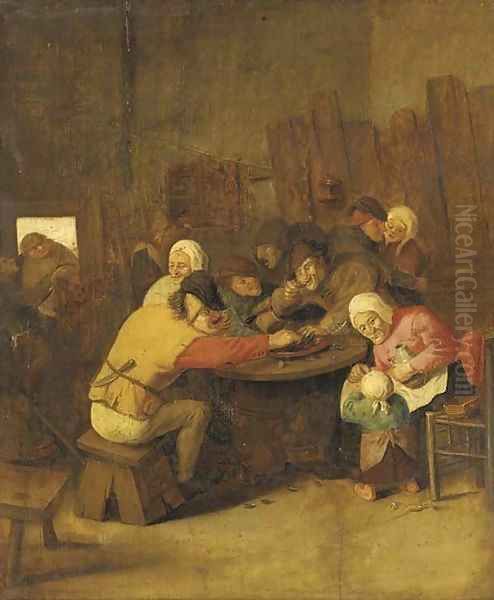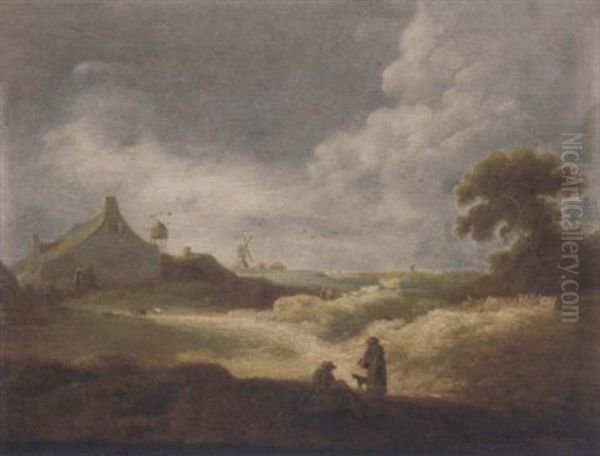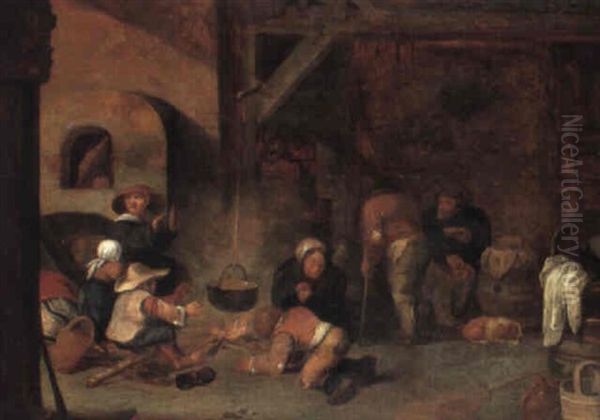
Pieter de Bloot (1601/1602–1658) stands as a notable figure within the vibrant tapestry of the Dutch Golden Age of painting. Primarily active in the bustling port city of Rotterdam, de Bloot carved a niche for himself as a painter of genre scenes, particularly those depicting the rustic lives of peasants, alongside occasional forays into landscape and biblical subjects. His work offers a valuable window into the everyday realities, social customs, and perhaps even the moral attitudes of the 17th-century Netherlands, rendered with a characteristic blend of realism, lively detail, and often, a touch of humor.
Rotterdam Roots and the Golden Age Context
Born and deceased in Rotterdam, Pieter de Bloot spent his entire working life immersed in the atmosphere of this major Dutch city. The Dutch Golden Age, roughly spanning the 17th century, was a period of extraordinary economic prosperity, scientific advancement, and cultural flourishing for the Dutch Republic. Freed from Spanish rule and fueled by global trade, the Republic saw the rise of a wealthy merchant class and a burgeoning bourgeoisie who became avid patrons of the arts.
Unlike in Catholic countries where the Church and aristocracy were the primary commissioners, Dutch art patronage was more broadly based among citizens. This led to a demand for art that reflected their lives, values, and interests. Consequently, genres like portraiture, landscape, seascape, still life, and scenes of everyday life (genre painting) thrived. Rotterdam, as a key trading hub, participated fully in this cultural boom, providing a fertile ground for artists like de Bloot.
The prevailing Calvinist ethos also subtly shaped artistic production. While overt religious imagery was less common than in Catholic regions, moralizing undertones often permeated secular subjects. Scenes depicting taverns, domestic life, or peasant activities could carry implicit messages about diligence, moderation, or the consequences of vice, aligning with Protestant values while still providing engaging visual narratives. De Bloot's work fits comfortably within this cultural and artistic milieu.
Artistic Style and Thematic Focus

Pieter de Bloot developed a distinctive style well-suited to his chosen subject matter. His approach was rooted in the detailed realism that characterized much of Dutch Golden Age painting. He possessed a keen eye for observation, capturing the textures of rough-spun clothing, the clutter of rural interiors, the specific gestures of work or leisure, and the play of light across surfaces.
A defining feature of his work is its liveliness and narrative quality. His canvases are often populated with numerous figures engaged in various activities, creating dynamic compositions that invite the viewer to explore the scene. He excelled at depicting human interaction, using naturalistic poses and facial expressions to convey emotions ranging from boisterous merriment to drunken stupor or interpersonal conflict. Humor is frequently present, stemming from the sometimes-uncouth behavior or exaggerated postures of his peasant subjects.
His primary focus was on peasant life. Tavern scenes, both interiors and exteriors, are recurrent themes, showing villagers drinking, smoking, playing games, dancing, or sometimes quarreling. He also depicted village fairs, domestic chores, rural labor, and occasionally, landscapes that served as settings for these activities. These works provide invaluable visual documentation of the clothing, tools, architecture, and social customs of the Dutch countryside during this period.
While known for genre scenes, de Bloot also painted landscapes, often featuring farmhouses or rural settings that complemented his interest in peasant life. Records also indicate he produced some biblical scenes, such as Christ Healing the Blind, demonstrating a broader thematic range, although these are less central to his overall reputation. His technique generally involved careful rendering, though perhaps less microscopically detailed than the Leiden 'fijnschilders' like Gerard Dou. His palette often favored earthy tones appropriate for his rustic subjects.
Influences and Artistic Dialogue
Like most artists of his time, Pieter de Bloot did not work in isolation. His style shows clear affinities with, and was likely influenced by, several contemporaries, most notably Adriaen Brouwer (c. 1605-1638). Brouwer, who worked in both the Southern Netherlands (Antwerp) and the Dutch Republic (Haarlem, Amsterdam), was a master of low-life genre scenes, renowned for his expressive, often rough depictions of peasants carousing and brawling in taverns. De Bloot adopted similar themes and a focus on capturing raw human behavior, though his style is often considered somewhat less gritty and more detailed than Brouwer's later, looser manner.

The influence of the Flemish painter David Teniers the Younger (1610-1690) has also been noted, particularly in relation to works like Peasants Making Merry Outside an Inn. Teniers was incredibly prolific and popular, known for his vast output of peasant scenes, kermesses (village fairs), and guardroom interiors. While Teniers often presented a slightly more idealized or picturesque view of rural life compared to Brouwer, his detailed execution and lively compositions find echoes in de Bloot's work.
Within the Rotterdam artistic community, de Bloot likely interacted with other painters. His subject matter, particularly tavern scenes, bears resemblance to works by Hendrick van der Borch II, who was also active in the city. Stylistic similarities have also been drawn between de Bloot and fellow Rotterdam artists like Cornelis Saftleven (1607-1681) and Hendrick Martensz. Sorgh (c. 1610-1670). Cornelis Saftleven, known for his landscapes, genre scenes (including peasant interiors), and animal paintings, may have been influenced by de Bloot, or perhaps the influence flowed in both directions, reflecting a shared artistic environment. Sorgh, too, specialized in genre interiors, market scenes, and portraits, sharing de Bloot's interest in depicting everyday Dutch life.
Comparing de Bloot to other Dutch genre painters helps place him in context. His focus on peasant life aligns him with Adriaen van Ostade (1610-1685) and his brother Isack van Ostade (1621-1649), both Haarlem artists who specialized in similar themes, though Adriaen often favored darker, more atmospheric interiors, while Isack excelled in lively outdoor scenes and winter landscapes. De Bloot's narrative complexity, however, rarely reaches the intricate, often satirical levels seen in the works of Jan Steen (c. 1626-1679).
Masterpieces and Notable Works
Among Pieter de Bloot's most recognized and representative works is Peasants Making Merry Outside an Inn. This painting exemplifies his strengths: a bustling composition filled with numerous figures engaged in drinking, dancing, conversation, and minor disputes. The setting is meticulously rendered, providing context and atmosphere. The individual figures are characterized through their distinct postures and expressions, contributing to the overall narrative of a lively, perhaps slightly chaotic, village gathering. Art historians have analyzed this work not just for its depiction of 17th-century peasant life but also for potential moralizing undertones, possibly commenting on the excesses of drink and revelry, a common theme in Dutch genre painting.

Another significant work is In de Taverne (In the Tavern), dated 1650. This interior scene likely showcases similar themes of peasant sociability and potential disorder within the confines of a rustic drinking establishment. Its mention as being held in a London auction house highlights the continued circulation and appreciation of his work beyond his lifetime.
Landscape with a Farmhouse represents his engagement with landscape painting. While perhaps secondary to his genre scenes, such works demonstrate his ability to capture the Dutch rural environment, often integrating architectural elements like farm buildings which were central to the lives of his peasant subjects. These landscapes provide a broader context for his figural scenes, emphasizing the connection between the people and their land.
Other attributed works, such as Interior of a Barn with Peasants, The Village Surgeon (or Dentist), and scenes depicting specific chores or professions, further illustrate the breadth of his interest in documenting the various facets of rural existence. Each painting contributes to a composite picture of 17th-century Dutch society, seen from the perspective of its common folk.
Teaching and Influence
Pieter de Bloot's contribution to Dutch art extended beyond his own creations; he also played a role as an educator. His most notable pupil was Abraham Hondius (c. 1625/1631–1691). Hondius, who was also potentially taught by Cornelis Saftleven, initially worked in Rotterdam before moving to Amsterdam and eventually London. While Hondius started with genre subjects somewhat akin to de Bloot's, he later became renowned primarily as a painter of animals, particularly dramatic hunting scenes and depictions of fighting beasts. De Bloot's instruction likely provided Hondius with a solid grounding in technique and observation, even if the pupil ultimately specialized in a different area.
The fact that artists like Cornelis Saftleven might have looked at de Bloot's work, as suggested by some art historical analyses regarding tavern interiors, indicates a degree of influence within his immediate circle. While perhaps not founding a major school or revolutionizing technique like Rembrandt van Rijn (1606-1669) or achieving the serene mastery of light seen in Johannes Vermeer (1632-1675), de Bloot's consistent production and engagement with popular themes ensured his work was known and contributed to the overall development of genre painting in Rotterdam and beyond. His influence lies more in the perpetuation and refinement of existing genre traditions than in radical innovation.
Historical Perspective and Legacy

In the grand narrative of the Dutch Golden Age, dominated by towering figures like Rembrandt, Vermeer, and Frans Hals (c. 1582-1666), Pieter de Bloot occupies the position of a highly competent and productive "minor master." This term is not dismissive; rather, it acknowledges artists who excelled within specific genres and contributed significantly to the richness and diversity of the era's artistic output, even if they didn't achieve the transformative impact of the very greatest names.
De Bloot's work is valued today primarily for its vivid and detailed portrayal of 17th-century Dutch peasant life. His paintings serve as important historical documents, offering insights into social customs, clothing, interiors, and the general atmosphere of rural communities. The humor and liveliness he captured continue to engage viewers. His connection to Rotterdam provides specific insight into the artistic production of that city, complementing the better-known schools of Amsterdam, Haarlem, Delft, or Leiden.
While his works were evidently popular during his lifetime, particularly appealing to the middle-class market for scenes of familiar life, detailed biographical information about him remains relatively scarce. Questions about the deeper symbolic meanings or precise moral messages embedded in his work are often open to interpretation, constituting some of the "unsolved mysteries" surrounding his oeuvre. There are no major controversies associated with his life or work; he appears to have been a steady producer within his chosen field.
Art historians appreciate de Bloot for his skill in composition, his ability to handle complex multi-figure scenes, and his contribution to the genre painting tradition influenced by Brouwer and Teniers. His paintings are held in various museum collections, ensuring his legacy endures as a skilled chronicler of his time. He represents the solid bedrock of talent upon which the spectacular peaks of the Dutch Golden Age were built.
Conclusion
Pieter de Bloot was a quintessential Dutch Golden Age genre painter, deeply rooted in his native Rotterdam. Through his detailed and lively canvases, he captured the essence of 17th-century peasant life – its work, its leisure, its celebrations, and its conflicts. Influenced by masters like Adriaen Brouwer, he developed a distinct style characterized by narrative richness, humor, and keen observation. While perhaps overshadowed in fame by some contemporaries, his works, such as the bustling Peasants Making Merry Outside an Inn, remain valuable both as artistic achievements and as historical records. As a painter and a teacher, de Bloot made a solid contribution to the extraordinary artistic flourishing of the Dutch Republic, leaving behind a body of work that continues to offer insight and enjoyment centuries later.